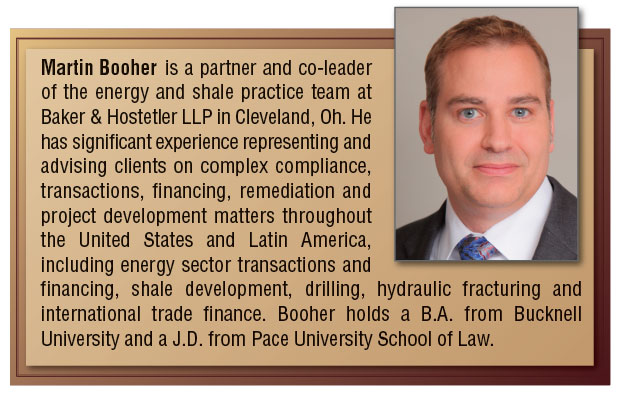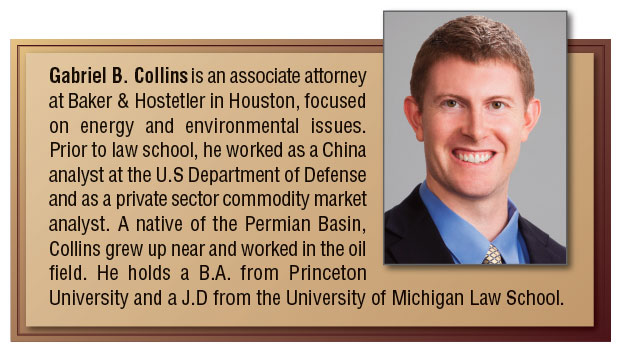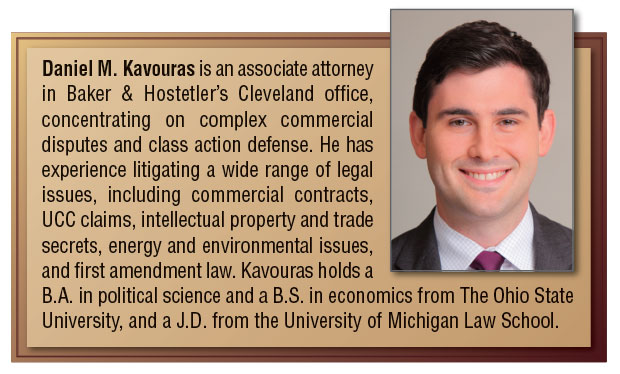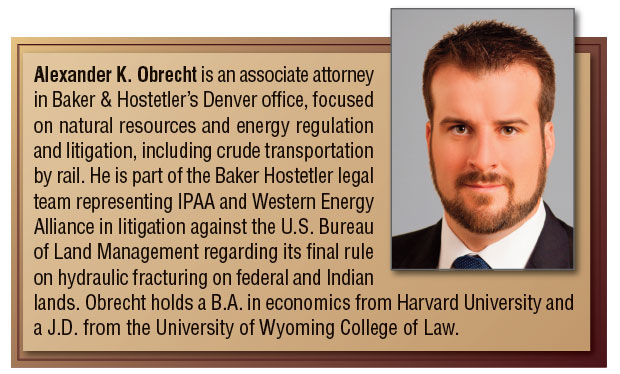
Legal Update
Regulatory Initiatives Target Oil And Gas
By Martin T. Booher, Gabriel B. Collins, Daniel M. Kavouras and Alexander K. Obrecht
CLEVELAND, OH.–The development of onshore unconventional oil and gas resources has led to a boom in the promulgation of regulations at both the federal and state levels that has not relented even with a major contraction in U.S. drilling and completion activity.
Earlier this year, the U.S. Bureau of Land Management published a proposed rule on venting and flaring on federal and Indian lands, which contains several requirements that would significantly impact operations if enacted. Phased in over three years, the rule would impose a monthly flaring limit of 1,800 Mcf per well and compel operators to capture, flare, use or reinject gas released during well completion and production operations. Comments on the rule are due by April 22.
The proposed rule would prohibit operators from venting gas in most situations, and disallow operators of new wells from purging emissions into the atmosphere. It would require operators to replace high-bleed pneumatic controllers with low-bleed controllers and pneumatic pumps with solar pumps. Moreover, the regulations would mandate that operators use “best management practices” when unloading liquids from existing wells, capture or flare gas vented from all storage tanks that vent more than six tons of volatile organic compounds per year, and use infrared cameras to survey producing sites for emissions at least twice annually.
The proposed rule has already drawn vociferous criticism from the industry. Aside from disagreement with the numerous new technical requirements, the rule sits on a shaky foundation. A central question will be whether BLM even has the regulatory authority to regulate air quality and emissions. With fundamental questions striking at the heart of the proposed rule, the BLM is unlikely to escape the rulemaking process without a lawsuit.
Hydraulic Fracturing
The venting and flaring rule follows BLM’s issuance last year of a final rule governing hydraulic fracturing on federal and Indian lands. After a prolonged regulatory review process that included more than 1.5 million public comments, the rule marks the federal government’s first attempt to specifically address hydraulic fracturing on federal lands. The regulations do not apply to wells on private or state-owned lands, but state regulations will continue to apply even where BLM has jurisdiction, as long as state regulations are at least as strict as BLM’s final rule.
The rule focuses on three areas: chemical disclosure, well integrity and wastewater storage. It follows the approach of 16 states that require operators to disclose the chemicals used in fracturing fluids on the FracFocus website registry within 30 days of completing a well, with limited exceptions to protect trade secrets. The rule also requires drillers to adhere to best practices for well integrity testing, including testing for pressure and cement returns.
The rule contains strict stipulations for storing hydraulic fracturing fluids, requiring operators to use above-ground, covered tanks to hold wastewater before it is transported and permanently disposed of. This regulation does away with open-pit storage permitted in many states, although many companies already use above-ground tanks for waste-water storage and recycling.
The Independent Petroleum Association of America and the Western Energy Alliance immediately filed a lawsuit in the U.S. District Court for the District of Wyoming challenging the BLM rule, and were subsequently joined by a number of states and sovereigns, including Wyoming, Colorado, Utah, North Dakota and the Ute Indian Tribe.
On Sept. 30, the court granted a motion for a preliminary injunction, preventing the BLM from enforcing the rule. The district court concluded that the industry challengers had presented credible evidence that the rule lacked a rational justification and was not supported by substantial evidence.
In addition, the court held that BLM likely lacks the authority to even regulate hydraulic fracturing. The imposition of such a legally infirm rule, the court concluded, would likely result in irreparable harm to oil and gas operators on federal and Indian lands, which existing federal and state rules already protect from environmental harm.
The preliminary injunction allows independent oil and gas producers to conduct operations on federal and Indian lands without the burden of additional BLM fracturing regulations while litigation over the legality of the rule is pending.
Crude By Rail
Through the Pipeline and Hazardous Materials Safety Administration and the Federal Railroad Administration, the Department of Transportation issued its final crude-by-rail rule last May. It mandates more stringent DOT-117 standards for new tank cars–along with retrofitting older ones–and imposes new operational controls. Despite the new rule, congressional and regulatory scrutiny remains focused on crude-by-rail transportation.
Aside from the short- and medium-term macroeconomic effects of increasing costs and barriers to oil transportation from shale plays, the rule imposes immediate compliance requirements from railroads and tank car owners. But producers and midstream transporters (“offerors” of crude oil) did not escape unscathed, either. Offerors must implement a new sampling and testing program to classify “unrefined petroleum-based products.”
Why is this important? Throughout the rule’s preamble, the agencies reiterate their commitment to increased inspections and enforcement actions against offerors that misclassify crude oil. Violations of the hazardous materials regulations (HMR) carry a civil penalty of $75,000 per violation, increasing to $175,000 per violation if injury or property damage occurs, with the option of potential criminal penalties that carry additional fines and even imprisonment.
The rule requires offerors to adopt a written sampling and testing program, which at a minimum, specifies:
- A frequency of sampling and testing that accounts for any appreciable variability of the material (history, temperature, method and location of extraction, time of year, length of time between shipments, etc.);
- Sampling prior to the initial offering of the material for transportation and when changes occur that may affect the properties of the material (mixing with other oils, processing or subsequent transportation);
- Sampling methods to ensure that a representative sample of the entire mixture, as offered, is collected;
- Testing methods that enable classification of the material under the HMR;
- Quality control measures for sampling frequencies;
- Duplicate sampling methods or equivalent measures for quality assurance;
- Criteria for modifying the sampling and testing program; and
- Testing or other appropriate methods used to identify properties of a mixture relevant to packaging requirements.
Although the regulatory language leaves much clarity to be desired, there is a silver lining. The agencies will allow compliance with the American Petroleum Institute’s Recommended Practice 3000 to satisfy the first six requirements. However, the agencies stress that “the boiling point test specified in RP 3000 does not align with the requirements currently authorized in the HMR.” Offerors must still use the boiling point testing methods prescribed by 49 C.F.R. § 173.120 for crude oil and § 173.115 for flammable gases.
In addition, the rule imposes new requirements for documentation, retention, review and dissemination of the sampling and testing program. Offerors must certify in individual shipping papers that the new sampling and testing requirements have been met, document the program in writing, and retain a copy of the program for at least a year or while the program is in effect. It also requires operators to review the program at least annually and ensure that updates are made as necessary, make copies of the program available to all employees responsible for its implementation, and maintain proper documentation for DOT inspections.
Even with potential legal challenges brewing, offerors should implement a compliance plan to meet the new classification requirements. At a minimum, offerors should implement RP 3000 as a baseline protocol ensuring boiling point testing that complies with 49 C.F.R. §§ 173.120 and 173.115, and develop new standards for a sampling and testing program.
Prohibiting Fracturing Bans
While New York passed legislation in 2015 to prohibit fracturing statewide, other states have gone in the opposite direction, often in spite of local anti-fracturing efforts at the county or municipal levels. For example, after lifting its moratorium on hydraulic fracturing in 2014, North Carolina became the 34th state to allow hydraulic fracturing within its borders when it began issuing permits last summer.
Texas enacted House Bill 40 last year to prohibit cities, towns and local municipalities from enacting fracturing bans. The law gives the state the exclusive jurisdiction over oil and gas operations and preempts the authority of other political subdivisions to regulate oil and gas operations, with some specified exceptions. The bill was introduced in the 2015 legislative session in response to a ban on local hydraulic fracturing passed with 59 percent of voter support in Denton in November 2014. HB 40 also preempts municipalities from enacting other regulations on oil and gas activities, including wastewater disposal. The law does not overturn Denton’s ban, but severely limits the city’s ability to enforce it moving forward.
Oklahoma lawmakers also enacted legislation last year in response to local efforts to ban hydraulic fracturing. SB 809 preserves local authority to pass reasonable zoning rules (for example, rules governing road use, noise, odors, fencing and setbacks), but it remains to be seen how this exception might apply to broadly applicable zoning restrictions that impact drilling and completion operations.
Vigilance remains important because despite curbs placed on local fracturing restrictions, activists continue to push to get similar measures on ballots across the country. In Colorado, 11 different proposals aimed at the oil and gas industry have been filed with the Colorado Legislative Council for the 2016 election. They include increasing setbacks to 4,000 feet and imposing a statewide fracturing ban. A similar initiative is in the works in Michigan.
Citing ongoing concerns over induced seismic activity and wastewater disposal wells, the Oklahoma Corporation Commission’s Oil & Gas Conservation Division has imposed a number of volume reductions and well shutdowns on underground injection wells covering a 122 square-mile area in the vicinity of the Arbuckle formation.
Moreover, the Oklahoma Supreme Court issued a landmark ruling last year that clears the way for individuals to sue energy companies for damages that result from earthquakes linked to oil and gas development activity. Justices rejected the industry’s argument that such cases should be resolved by the Corporation Commission rather than by the courts.
Neighboring Kansas also took steps to reduce wastewater injection volumes after declaring earthquakes in two counties bordering Oklahoma “an immediate threat to public health, safety and welfare.” The Kansas Corporation Commission ordered operators to reduce injection in increments, starting with 16,000 barrels of saltwater a day within 10 days, and ending with 8,000 bbl/d within 100 days of the order. Violators are subject to fines of up to $10,000 a day.
Royalty Enforcement
The Department of Interior’s Office of Natural Resources Revenue (ONRR) continues its enforcement of royalty payment obligations under the False Claims Act (FCA), particularly on Indian leases. By rule, all energy companies that have a producing federal or Indian lease must submit reports of production and royalty payments to ONRR. In the case of Indian leases, ONRR then receives these royalty payments as a trustee and verifies that the payments are correct before distributing them to leaseholders.
The momentum behind this movement comes as a combination of the Department of Justice stepping up its investigations and filing cases under the FCA, and increased activity among whistleblowers. Over the past 15 years, many of the settlements individually brought from $10 million to $100 million per case.
Royalty settlements have historically come at high costs to accused oil and gas companies. In 2015, ONRR issued a $6.9 million civil penalty to High Plains Gas Inc. for failure to submit production reports for numerous federal leases in Wyoming. It was the largest civil penalty issued by ONRR in nearly a decade, and appears to be the single largest civil penalty the agency has ever issued for failure to submit production reports.
In total, ONRR assessed more than $11.5 million in civil penalties in 2015, focusing its enforcement and collection efforts primarily on federal and Indian leases in Wyoming, New Mexico, Colorado, North Dakota, South Dakota, Utah, Oklahoma, Ohio and offshore in the Gulf of Mexico. Civil penalties in 2015 were most often issued for failing to submit production and royalty reports.
Oil And Gas Litigation
Lawsuits over unpaid overtime and wages under the Fair Labor Standards Act (FLSA) rose sharply in 2015, particularly in the District Courts covering the Permian Basin and Eagle Ford Shale in Texas. According to Androvett Legal Media, there were 299 FLSA suits filed in the Western District of Texas and 515 such suits filed in the Southern District of Texas in 2015. This total of 814 FLSA lawsuits is a nearly 32 percent increase over the 617 FLSA actions filed in these two courts in 2014.
The allegations underlying these lawsuits vary from a failure to pay overtime to mis-classification as exempt from overtime or independent contractors. The Department of Labor has taken a keen interest in the oil and gas industry, collecting $22.3 million in wages on behalf of 4,700 workers in the agency’s Southwest region (which includes Texas and 10 other states).
An example of an FLSA case–albeit one from outside Texas–is Mazzarella v. Fast Rig Support LLC, an overtime suit by drivers hauling water to well sites. Fast Rig argued that the drivers were exempt from overtime requirements because of an exemption in the federal Motor Carrier Act, which applies when employees are transporting property in interstate commerce on public highways and the employees’ activities impact safe operations.
But the U.S. District Court for the Middle District of Pennsylvania rejected Fast Rig’s argument, ruling that that drivers who transported water to drilling locations were not exempt from the overtime requirements because the water was not used in a “continuous stream of commerce,” but was instead interrupted by the drilling activities, which turned the freshwater into wastewater transported away for disposal.
Water is at the center of another lawsuit in Texas, Coyote Lake Ranch LLC v. the City of Lubbock. The case deals with the question of whether the “accommodation doctrine” should apply when a groundwater estate has been severed from the surface estate. Under the accommodation doctrine, the owner of a mineral estate can use as much of the surface estate as is reasonably necessary to extract and produce minerals.
In September 2015, the Texas Supreme Court agreed to hear the case and oral argument was held in October 2015. At oral argument, counsel for Coyote Lake Ranch argued that the court should adopt a standard that would protect productive use of the groundwater and surface estates when they are separately owned. Additionally, Coyote Lake Ranch argued that the groundwater estate should, similarly to the mineral estate, be recognized as dominant to the surface estate and be required to accommodate the surface use of the property.
The City of Lubbock countered that historical precedent did not support placing the ground-water estate on the same plane as the mineral estate. Dale Wainwright, Lubbock’s counsel, stated, “There is a centuries-old understanding that the mineral estate is dominant. To all of a sudden find that for groundwater, it would create tremendous angst and potentially incredible litigation to figure out what that means if the court were to decide after centuries another estate is dominant.”
As of mid-April, the court’s decision remained pending, but the issue of whether the groundwater estate is under a duty to reasonably accommodate surface uses of property will only continue to grow in importance.
The future promises more regulation both at the state and federal levels, and energy companies must continue to deal with a changing regulatory landscape and increased litigation. However, not all the news on the regulatory and legislative front is discouraging. A case in point is the U.S. Environmental Protection Agency’s 2015 report on the potential impacts of hydraulic fracturing on drinking water. Four years in the making, the report found only a very small number of identified cases where hydraulic fracturing impacted drinking water resources, and did not find any evidence of widespread, systemic impacts caused by fracturing.
Another example was the U.S. Fish & Wildlife Service determination last year that the greater sage-grouse did not require protection under the Endangered Species Act. The greater sage-grouse’s population recovered despite higher levels of oil and gas development, and the fact that many western states have suffered from drought conditions over the past three years (twice the average life span of the greater sage-grouse). The greater sage-grouse gives the oil and gas industry a successful template of how to effectively balance the interests of conservationists, land users and energy developers.
For other great articles about exploration, drilling, completions and production, subscribe to The American Oil & Gas Reporter and bookmark www.aogr.com.

















